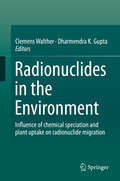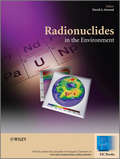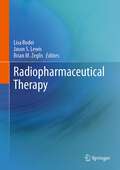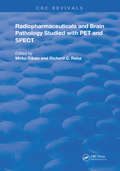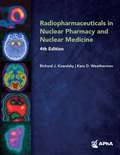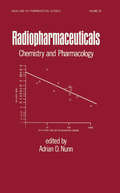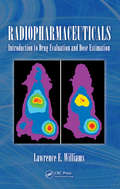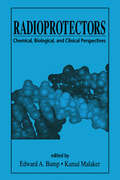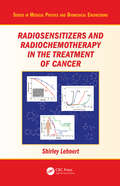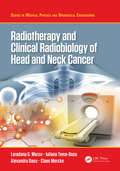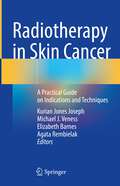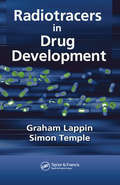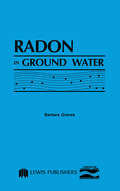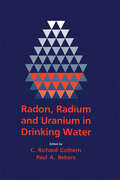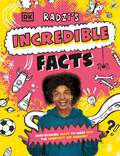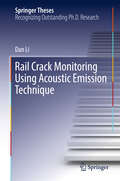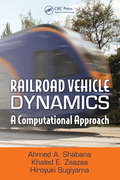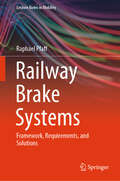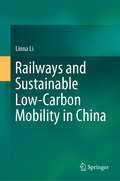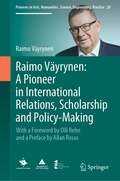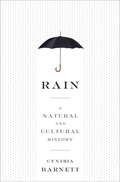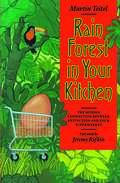- Table View
- List View
Radionuclides in the Environment
by Dharmendra K. Gupta Clemens WaltherThis book provides extensive and comprehensive information to researchers and academicians who are interested in radionuclide contamination, its sources and environmental impact. It is also useful for graduate and undergraduate students specializing in radioactive-waste disposal and its impact on natural as well as manmade environments. A number of sites are affected by large legacies of waste from the mining and processing of radioactive minerals. Over recent decades, several hundred radioactive isotopes (radioisotopes) of natural elements have been produced artificially, including 90Sr, 137Cs and 131I. Several other anthropogenic radioactive elements have also been produced in large quantities, for example technetium, neptunium, plutonium and americium, although plutonium does occur naturally in trace amounts in uranium ores. The deposition of radionuclides on vegetation and soil, as well as the uptake from polluted aquifers (root uptake or irrigation) are the initial point for their transfer into the terrestrial environment and into food chains. There are two principal deposition processes for the removal of pollutants from the atmosphere: dry deposition is the direct transfer through absorption of gases and particles by natural surfaces, such as vegetation, whereas showery or wet deposition is the transport of a substance from the atmosphere to the ground by snow, hail or rain. Once deposited on any vegetation, radionuclides are removed from plants by the airstre am and rain, either through percolation or by cuticular scratch. The increase in biomass during plant growth does not cause a loss of activity, but it does lead to a decrease in activity concentration due to effective dilution. There is also systemic transport (translocation) of radionuclides within the plant subsequent to foliar uptake, leading the transfer of chemical components to other parts of the plant that have not been contaminated directly.
Radionuclides in the Environment
by David A. AtwoodNuclear energy is the one energy source that could meet the world's growing energy needs and provide a smooth transition from fossil fuels to renewable energy in the coming decades and centuries. It is becoming abundantly clear that an increase in nuclear energy capacity will, and probably must, take place.However, nuclear energy and the use of radionuclides for civilian and military purposes lead to extremely long-lived waste that is costly and highly problematic to deal with. Therefore, it is critically important ot understand the environmental implications of radionuclides for ecosystems and human health if nuclear energy is to be used to avoid the impending global energy crisis. The present volume of the EIC Books series addresses this critical need by providing fundamental information on environmentally significant radionuclides.The content of this book was developed in collaboration with many of the authors of the chapters. Given the enormity of the subject the Editor and the Authors had to be judicious in selecting the chapters that would appropriately encompass and describe the primary topics, particularly those that are of importance to the health of ecosystems and humans. The resulting chapters were chosen to provide this information in a book of useful and appropriate length. Each chapter provides fundamental information on the chemistry of the radionuclides, their occurrence and movement in the enivornment, separation and analyses, and the technologies needed for their remediation and mitigation. The chapters are structured with a common, systematic format in order to facilitate comparions between elements and groups of elements.About EIC BooksThe Encyclopedia of Inorganic Chemistry (EIC) has proved to be one of the defining standards in inorganic chemistry, and most chemistry libraries around the world have access either to the first of second print editon, or to the online version. Many readers, however, prefer to have more concise thematic volumes, targeted to their specific area of interest. This feedback from EIC readers has encouraged the Editors to plan a series of EIC Books, focusing on topics of current interest. They will appear on a regular basis, and will feature leading scholars in their fields. Like the Encyclopedia, EIC Books aims to provide both the starting research student and the confirmed research worker with a critical distillation of the leading concepts in inorganic and bioinorganic chemistry, and provide a structured entry into the fields covered.This volume is also available as part of Encyclopedia of Inorganic Chemistry, 5 Volume Set.This set combines all volumes published as EIC Books from 2007 to 2010, representing areas of key developments in the field of inorganic chemistry published in the Encyclopedia of Inorganic Chemistry. Find out more.
Radiopharmaceutical Therapy
by Jason S. Lewis Brian M. Zeglis Lisa BodeiThis book covers foundational topics in the emerging field of radiopharmaceutical therapy. It is divided into three sections: fundamentals, deeper dives, and special topics. In the first section, the authors examine the field from a bird’s-eye view, covering topics including the history of radiopharmaceutical therapy, the radiobiology of radiopharmaceutical therapy, and the radiopharmaceutical chemistry of both metallic and non-metallic radionuclides. The second section provides a more in-depth look at specific radiotherapeutics. Chapters include broader discussions of the different platforms for radiopharmaceutical therapy as well as more focused case studies covering individual radiotherapeutics. The third and final section explores a number of areas for further study, including medical physics, artificial intelligence, in vivo pretargeting, theranostic imaging, and the regulatory review process for radiotherapeutics.This book is the first of its kind and is useful for a broad audience of scientists, researchers, physicians, and students across a range of fields, including biochemistry, cancer biology, nuclear medicine, radiology, and radiation oncology.
Radiopharmaceuticals and Brain Pathophysiology Studied with Pet and Spect: Studied With Pet And Spect (Routledge Revivals)
by M. Diksic Richard C. RebaFirst published in 1991, this book covers three major areas essential to in vivo biochemical studies with PET and SPECT: synthesis of radiopharmaceuticals, biological modeling, and clinical applications. The book emphasizes advances in the synthesis of radiopharmaceuticals used in PET and SPECT studies of brain flow and oxidatative metabolism, in addition to biological modeling. The most widely used 2-deoxyglucose/2-fluorodeoxyglucose models are discussed, as well as models used in the quantitation of brain receptors. Other topics include a possible model for converting 6-[18F] fluorodopa images into the quantitative rate of dopamine synthesis, evaluations of technetium- and iodine-labeled blood flow tracers, and possibilities for using SPECT to measure other pathophysiological variables. This book will be a valuable reference source to students and specialists interested in these in vivo measurements.
Radiopharmaceuticals in Nuclear Pharmacy and Nuclear Medicine
by Richard J. Kowalsky Kara D. WeathermanAs with previous editions of this textbook, Radiopharmaceuticals in Nuclear Pharmacy and Nuclear Medicine, Fourth Edition, provides a comprehensive introduction to radiopharmaceuticals and their applications in nuclear medicine. With the increasing emphasis on PET and the expanding role of theranostics, the nuclear medicine community continues to grow as evidenced by the development of several new radiopharmaceuticals and technologies for diagnostic and therapeutic applications in recent years. The book is intended for use in courses taught in the disciplines of nuclear pharmacy, nuclear medicine technology, and nuclear medicine. The chapter topics are of moderate depth and breadth and are referenced to the primary literature. As such, this textbook has become a useful resource for professional practitioners in these disciplines and for those preparing for specialty board examination.
Radiopharmaceuticals: Chemistry and Pharmacology
by Adrian D. NunnThis timely resource compares single-photon emission tomography (SPECT), used mainly withTechnetium and iodine for routine clinical examinations, and positron emission tomography(PET) , employing short-lived radionuclides of carbon, oxygen, nitrogen, and fluorine in researchinvestigations.Presenting the logic behind why one approach is better than another in various circumstances,Radio pharmaceuticals details the use of radiolabelled substrates in measuring the effect of diseaseand drugs on regional metabolism and receptor concentration/occupancy .. . discusses factorsaffecting the selective retention of small metal complexes by various tissues .. . analyzes the interactionof small exogenous metal complexes with enzymes in vivo and the critical role of stereochemistry. . . explores the use of radio labelled compounds in the study of neuroactive compounds,neurotransmitters, enzyme inhibitors, and substrates in vivo .. . covers the design and pharmacologyof radiolabelled drugs as probes of site of action , selectivity and specificity, and pharmacokineticsin vivo .. . and more.Extensively referenced with over l 050 bibliographic citations, Radiopharmaceuticals is a state-ofthe-art guide for pharmacists; organic, medicinal , and radiopharmaceutical chemists; pharmacokineticists;nuclear medicine physicians and technologists; neurochemists; and governmentregulatory personnel .
Radiopharmaceuticals: Introduction to Drug Evaluation and Dose Estimation
by Ph.D., Lawerence WilliamsNanoengineering, energized by the desire to find specific targeting agents, is leading to dramatic acceleration in novel drug design. However, in this flurry of activity, some issues may be overlooked. This is especially true in the area of determining dosage and evaluating the effects of multiple agents designed to target more than one site of met
Radioprotectors: Chemical, Biological, and Clinical Perspectives
by Edward A. Bump Kamal MalakerIt is essential to minimize damage to normal tissues during radiation therapy and many strategies have been employed in finding the best methods for radioprotection. This book integrates chemical, biological, and clinical perspectives on these strategies and developments, providing a comprehensive treatise. It emphasizes new concepts in radioprotection, aiming to inspire further basic science and clinical progress in radioprotector research. Radioprotectors: Chemical, Biological, and Clinical Perspectives includes the following topics:Early research on radioprotectorsWR-2721, an aminothiol prodrug, as a radioprotectorNew results with naturally occurring thiolsNitroxides as effective radioprotectors in vitro and in vivoRadioprotection observed with radical scavengers or antioxidantsBone marrow radioprotection with cytokines and biological modifiersMultiple mechanisms of altering radiation response by eicosanoidsVascular response to radiation and the importance of vascular damage to normal tissue Modifiers of radiation-induced apoptosisSurvey of clinical trials with radioprotectorsRadiation biologists and oncologists, cancer researchers, and toxicologists will benefit from the findings discussed and strategies for future research.
Radiosensitizers and Radiochemotherapy in the Treatment of Cancer (Series in Medical Physics and Biomedical Engineering)
by Shirley LehnertRadiosensitizers and Radiochemotherapy in the Treatment of Cancer catalogs and describes the mechanism of action for entities characterized as radiosensitizers. Developments in the biological and physical sciences have introduced new radiosensitizers and defined novel targets for radiosensitization. As a result, a book about radiosensitization must
Radiotheranostics - A Primer for Medical Physicists I: Physics, Chemistry, Biology and Clinical Applications (ISSN)
by Cari Borrás Michael G. StabinThis book covers scientific, clinical, and educational aspects of radiotheranostics in cancer control. Setting the framework, the first volume defines radiotheranostics and describes the history of radionuclide therapy and theranostics, and the biology of cancer. It examines the clinical applications of unconjugated radionuclides, such as ¹³¹I and ²²³Ra, and of radionuclide-conjugated cancer-specific vectors: peptides, small molecules, antibodies, and nanoparticles; introduces clinical trials and drug development; and reviews epidemiological studies and the adverse effects of radionuclide therapy – both radiation injuries and chemical toxicity. It presents the chemistry and physics of radionuclide production, discusses radioactivity measurements and traceability, and addresses important instrumentation aspects: calibration, quantitative imaging, and quality control. Volume I concludes with guidance on the education, training, and competence of a radiotheranostic multidisciplinary team and summarizes the principal physics characteristics of theranostics today – including many to be expanded in the second volume – while offering a glimpse into tomorrow. This volume provides the foundations for the more advanced second volume, which explores dosimetric and radiation safety, aiming to empower medical physicists and demonstrate to the cancer community how to improve cancer control and yield increased patient survival times.It will be a valuable reference for medical and health physicists with basic knowledge of nuclear medicine.Key Features• Provides a comprehensive introduction to the topic, presenting readers with thorough treatment in a cohesive two-volume book.• Presents a rigorous approach while remaining accessible to students and trainees in the field.• Contains consistent and extensive references to allow readers to delve deeper into the subject.
Radiotherapy Treatment Planning: Linear-Quadratic Radiobiology
by Alan E. Nahum J. Donald ChapmanUnderstand Quantitative Radiobiology from a Radiation Biophysics PerspectiveIn the field of radiobiology, the linear-quadratic (LQ) equation has become the standard for defining radiation-induced cell killing. Radiotherapy Treatment Planning: Linear-Quadratic Radiobiology describes tumor cell inactivation from a radiation physics perspective and of
Radiotherapy and Clinical Radiobiology of Head and Neck Cancer (Series in Medical Physics and Biomedical Engineering)
by Loredana G. Marcu Iuliana Toma-Dasu Alexandru Dasu Claes MerckeCommon factors that lead to treatment failure in head and neck cancer are the lack of tumour oxygenation, the accelerated division of cancer cells during treatment, and radioresistance. These tumour-related challenges and possible ways to overcome them are covered in this book, authored by three medical physicists and a clinical oncologist who explain how different radiobiological findings have led to the development of various treatment techniques for head and neck cancer. <P><P>Novel treatment techniques as supported by current scientific evidence are comprehensively explored, as well as the major challenges that arise in the retreatment of patients who have already undergone a form of radiotherapy for primary head and neck cancer. <P><P>Features: <li>Uses an interdisciplinary approach, encompassing clinical aspects of radiotherapy, radiation biology, and medical physics <li>Applies content by relating all radiobiological characteristics to their respective clinical implications <li>Explains the radiobiological rationale for all previous and current clinical trials for head and neck cancer
Radiotherapy in Skin Cancer: A Practical Guide on Indications and Techniques
by Elizabeth Barnes Agata Rembielak Kurian Jones Joseph Michael J. VenessRadiotherapy is one of the major treatment modalities utilised for the management of patients diagnosed with skin cancer. This book describes the indications and the various radiotherapy techniques used to treat skin cancer. The technical details of radiotherapy are well addressed and serve as a practical reference to those clinicians involved in managing these patients. The authors are all leading radiation oncologists from the major cancer centers in the USA, Canada, UK & Australia. Skin Radiotherapy is an essential resource for practicing medical professionals such as radiation oncologists, dermatologists, radiation therapists and residents preparing for board examinations.
Radiotracers in Drug Development
by Graham Lappin Simon TempleAlthough there are numerous books on drug metabolism, Radiotracers in Drug Development is unique in explaining how radiotracers are used to elucidate a drug's absorption, distribution, metabolism, and excretion (ADME). Covering traditional and recent technologies and applications, the book takes a strong industrial approach, discussing the b
Radium and the Secret of Life
by Luis A. CamposBefore the hydrogen bomb indelibly associated radioactivity with death, many chemists, physicians, botanists, and geneticists believed that radium might hold the secret to life. Physicists and chemists early on described the wondrous new element in lifelike terms such as “decay” and “half-life,” and made frequent references to the “natural selection” and “evolution” of the elements. Meanwhile, biologists of the period used radium in experiments aimed at elucidating some of the most basic phenomena of life, including metabolism and mutation. From the creation of half-living microbes in the test tube to charting the earliest histories of genetic engineering, Radium and the Secret of Life highlights previously unknown interconnections between the history of the early radioactive sciences and the sciences of heredity. Equating the transmutation of radium with the biological transmutation of living species, biologists saw in metabolism and mutation properties that reminded them of the new element. These initially provocative metaphoric links between radium and life proved remarkably productive and ultimately led to key biological insights into the origin of life, the nature of heredity, and the structure of the gene. Radium and the Secret of Life recovers a forgotten history of the connections between radioactivity and the life sciences that existed long before the dawn of molecular biology.
Radon in Ground Water
by National Water Well Assoc.This new book focuses on sampling and analysis, radon and radium in water supply wells, predictive models, geologic and hydrogeologic controls that influence radon occurrence, monitoring radon and other radioactivity from geologic sources and mining impacts on occurrence of radioactivity in ground water. Also discussed are occurrence, testing, treatment, and reduction of radon from groundwater. Because the most severe health hazard from indoor radioactivity results from inhalation of short-lived radioactive decay products of radon, the EPA scheduled a major conference early in 1987 on Radon, Radium, and Other Radioactivity in Ground Water-Hydrogeologic Impact and Application to Indoor Airborne Contamination. The result is this book.
Radon, Radium, and Uranium in Drinking Water
by C. Richard CothernWith new regulations for radionuclides in drinking water, this volume will be valuable for understanding where radionuclides come from, how their prescence is determined, where humans come in contact with them, health effects consequences (both for individuals and communities), removal from water, disposal problems and cost implications.
Radzi's Incredible Facts: Mind-Blowing Facts to Make You the Smartest Kid Around!
by Radzi ChinyanganyaA book for curious kids filled with unforgettable facts, from the brilliant to the bizarre! What’s the furthest distance ever run without stopping? Which language has the most words? How many times do we blink each day, year, or in an entire lifetime? How deep is the deepest hole that’s ever been dug? How hot are the world’s hottest chilies? Do you know the answers? If not, then this fact book is for you.This fun and educational book for children aged 5-9 is packed with quirky questions and answers about every topic you can possibly think of. Learn about feminism, ears, pirates, and even belly buttons, Radzi’s Incredible Facts will have curious minds hooked. No question is too random for Radzi!This exciting children’s fact book offers:- Key topics for children, from bizarre facts about the human body and incredible historical figures, to unbelievable sporting feats and amazing animals.- An intriguing question and answer format that clearly groups topics to generate interest and engage young readers.- Content by the author of well-known UK children’s television personality Radzi Chinyanganya – former presenter of the BBC’s Blue Peter.- A balance of text and illustrations on each page, making it engaging for young readers.Kids can dazzle their friends and family with unforgettable facts and astounding information from former Blue Peter presenter Radzi Chinyanganya. Young minds are so inquisitive and always asking questions! Ever wondered where to find the answers to tricky and curious questions about everything, from sleep to snow and diseases to diamonds? Then look no further! This book is brimming with questions and answers you didn’t even know you needed.
Rail Crack Monitoring Using Acoustic Emission Technique (Springer Theses)
by Dan LiThis thesis provides an innovative strategy for rail crack monitoring using the acoustic emission (AE) technique. The field study presented is a significant improvement on laboratory studies in the literature in terms of complex rail profile and crack conditions as well as high operational noise. AE waves induced by crack propagation, crack closure, wheel-rail impact and operational noise were obtained through a series of laboratory and field tests, and analyzed by wavelet transform (WT) and synchrosqueezed wavelet transform (SWT). A wavelet power-based index and the enhanced SWT scalogram were sequentially proposed to classify AE waves induced by different mechanisms according to their energy distributions in the time–frequency domain. A novel crack sizing method taking advantage of crack closure-induced AE waves was developed based on fatigue tests in the laboratory. The propagation characteristics of AE waves in the rail were investigated, and Tsallis synchrosqueezed wavelet entropy (TSWE) with time was finally brought forward to detect and locate rail cracks in the field. The proposed strategy for detection, location and sizing of rail cracks helps to ensure the safe and smooth operation of the railway system. This thesis is of interest to graduate students, researchers and practitioners in the area of structural health monitoring.
Railroad Vehicle Dynamics: A Computational Approach
by Ahmed A. Shabana Khaled E. Zaazaa Hiroyuki SugiyamaThe methods of computational mechanics have been used extensively in modeling many physical systems. The use of multibody-system techniques, in particular, has been applied successfully in the study of various, fundamentally different applications. Railroad Vehicle Dynamics: A Computational Approach presents a computational multibody-system
Railway Brake Systems: Framework, Requirements, and Solutions (Lecture Notes in Mobility)
by Raphael PfaffThis book offers a timely introduction to railway brake systems. It introduces operational aspects as well as a set of rail vehicle specific requirements, such as wheel-rail contact and rail vehicle dynamics. It discusses the process of brake control, in particular for automatic pneumatic brake system and brake systems for multiple units. In turn, the book gives insights into braking force generation, covering both friction brake systems and regenerative brakes. It also describes performance calculations, discussing concepts for brake systems design. Despite the focus is mainly on European braking systems, the book identifies key and general aspects, thus offering an inspiring reading for researchers and professionals that are active both inside and outside of Europe.
Railways and Sustainable Low-Carbon Mobility in China
by Linna LiThis book explores the role of railways in developing sustainable low-carbon mobility by analyzing the intermodal relationship between railways and other transport modes. Focusing on geographical and governance perspectives, and taking China as a case study, it analyzes the competition and cooperation between and integration of railways and other transport modes, in order to provide guidance on future sustainable transport development. Firstly, the book examines the contribution of railways to low carbon emissions in China over recent decades by estimating the carbon dioxide emissions from various transport modes in China at national and regional levels using decomposition analysis. It then discusses the current competition and cooperation between railways and other transport modes, as well as their integration and the impact of their relationship on climate change. It also highlights how the competition between railways and other transport modes may change the passenger flows between city pairs and so alter transport carbon emissions and examines how cooperation and integration could improve passengers’ travel experience while at the same time reducing carbon emissions. Lastly, it addresses the implications for future sustainable transport development based on institutional analysis. Presenting multidisciplinary, sustainable transport research on the role of railways in reducing carbon emissions, and also offering policy recommendations for developing low-carbon, integrated transport in the future, this book is a valuable reference resource for graduates, researchers, and government managers responsible for transport development, urban planning and environmental policy.
Raimo Väyrynen: With a Foreword by Olli Rehn and a Preface by Allan Rosas (Pioneers in Arts, Humanities, Science, Engineering, Practice #28)
by Raimo VäyrynenThis book provides a broad overview of Professor Raimo Väyrynen’s academic work, his role in international research organizations, and his contributions to policy debates. It offers an interesting review of important political issues during the time span of half a century, from disarmament in Europe to the changing relationship between state sovereignty and transnational forces. Väyrynen has dealt with the changing agenda of peace and international relations, security and the arms race, and the world economy. This book provides comprehensive analyses of the regional and systemic structure of international relations, with the emphasis on conflicts and warfare between nations. It argues that while states, even smaller ones, still matter, transnational issues are increasingly important. Taking a historical perspective, the articles suggest that large-scale violence and arms races have been recurrent and cyclical phenomena in international relations. These events reflect the deep-seated inequalities in the political and economic systems which, moreover, vary considerably between regions. The publication is important reading for any researcher as well as students, policy-makers and the science-oriented public at large. • Traces the changing agenda of international relations from disarmament and the world economy to the changing relationship between state sovereignty and transnational forces. • Provides analyses of the regional and systemic structure in international relations, with the emphasis on conflicts and warfare. • Argues that large-scale violence and the arms race have been recurrent and cyclical phenomena in international relations. • Reviews important political issues from peace and conflict in Europe to the changing power relationship in the world.
Rain
by Cynthia BarnettRain is elemental, mysterious, precious, destructive. It is the subject of countless poems and paintings; the top of the weather report; the source of the world's water. Yet this is the first book to tell the story of rain. Cynthia Barnett's Rain begins four billion years ago with the torrents that filled the oceans, and builds to the storms of climate change. It weaves together science--the true shape of a raindrop, the mysteries of frog and fish rains--with the human story of our ambition to control rain, from ancient rain dances to the 2,203 miles of levees that attempt to straitjacket the Mississippi River. It offers a glimpse of our "founding forecaster," Thomas Jefferson, who measured every drizzle long before modern meteorology. Two centuries later, rainy skies would help inspire Morrissey's mopes and Kurt Cobain's grunge. Rain is also a travelogue, taking readers to Scotland to tell the surprising story of the mackintosh raincoat, and to India, where villagers extract the scent of rain from the monsoon-drenched earth and turn it into perfume. Now, after thousands of years spent praying for rain or worshiping it; burning witches at the stake to stop rain or sacrificing small children to bring it; mocking rain with irrigated agriculture and cities built in floodplains; even trying to blast rain out of the sky with mortars meant for war, humanity has finally managed to change the rain. Only not in ways we intended. As climate change upends rainfall patterns and unleashes increasingly severe storms and drought, Barnett shows rain to be a unifying force in a fractured world. Too much and not nearly enough, rain is a conversation we share, and this is a book for everyone who has ever experienced it.From the Hardcover edition.
Rain Forest in Your Kitchen: The Hidden Connection Between Extinction And Your Supermarket
by Jeremy Rifkin Martin TeitelThe biodiversity crisis -- the extinction of thousands of species of plants and animals -- is not just a faraway problem for scientists to solve. Instead, the crisis is as close as our backyards, our gardens, and our refrigerator shelves. This engaging, practical guide inspires average Americans to wield their consumer power in favor of protecting the world's plant and animal species.Environmentalist activist Martin Teitel offers compelling evidence that by slightly modifying how we shop, eat, and garden, we can collectively influence the operating decisions of today's corporate agribusiness and help preserve our precious genetic resources. Teitel offers strategies so simple that they require no significant lifestyle change or expense.
